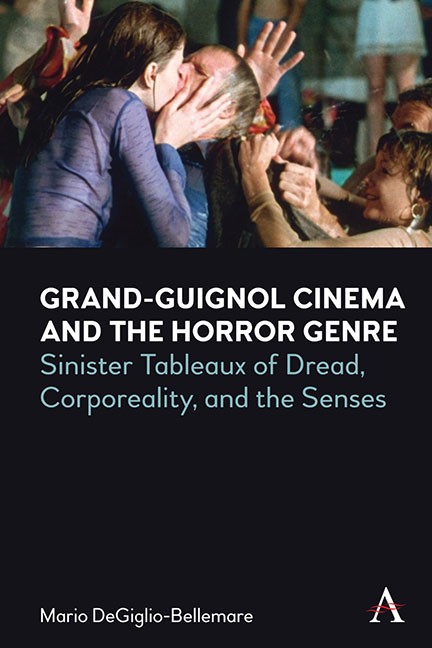Book contents
- Frontmatter
- Dedication
- Contents
- Miscellaneous Frontmatter
- Introduction: Grand-Guignol Cinema and the Senses: Eyes Without a Face, Attractions, Affect and Facial Trauma
- Chapter One The Grand-Guignol Theatre: A Short History of theTheatre and Spatial Ecologies of Dread The Hitch-Hiker and Shivers
- Chapter Two Grotesque Carnivals of “Stubborn” Aurality: Embodied Discourse in Early Talkie Horror Cinema Murders in the Rue Morgue, Freaks, and The Black Cat
- Chapter Three The Sight of Corpses in the Ruins of Modernity: Surgical Sadists under Censorship: The Body Snatcher, and Mad Love, The Blood of the Beasts
- Chapter Four Erotic Abattoirs of Bad Taste: Unproductive Potlatch in Exploitation Cinema: Fascination, Grapes of Death, and Salò, or 120 Days of Sodom
- Chapter Five French Colonial Skinning: Affect and Becoming-Wound in the Cinema of Sensation: Trouble Every Day, Sombre, and In My Skin
- Conclusion: Drag Performativity and Multisensorial Dread Blood and Black Lace and Psycho
- Bibliography
- Index
Chapter Three - The Sight of Corpses in the Ruins of Modernity: Surgical Sadists under Censorship: The Body Snatcher, and Mad Love, The Blood of the Beasts
Published online by Cambridge University Press: 15 November 2023
- Frontmatter
- Dedication
- Contents
- Miscellaneous Frontmatter
- Introduction: Grand-Guignol Cinema and the Senses: Eyes Without a Face, Attractions, Affect and Facial Trauma
- Chapter One The Grand-Guignol Theatre: A Short History of theTheatre and Spatial Ecologies of Dread The Hitch-Hiker and Shivers
- Chapter Two Grotesque Carnivals of “Stubborn” Aurality: Embodied Discourse in Early Talkie Horror Cinema Murders in the Rue Morgue, Freaks, and The Black Cat
- Chapter Three The Sight of Corpses in the Ruins of Modernity: Surgical Sadists under Censorship: The Body Snatcher, and Mad Love, The Blood of the Beasts
- Chapter Four Erotic Abattoirs of Bad Taste: Unproductive Potlatch in Exploitation Cinema: Fascination, Grapes of Death, and Salò, or 120 Days of Sodom
- Chapter Five French Colonial Skinning: Affect and Becoming-Wound in the Cinema of Sensation: Trouble Every Day, Sombre, and In My Skin
- Conclusion: Drag Performativity and Multisensorial Dread Blood and Black Lace and Psycho
- Bibliography
- Index
Summary
This chapter examines the Val Lewton-produced and Robert Wise-directed film The Body Snatcher (1945), as well as other key Grand-Guignol films in the censorship period (1934–68), in order to challenge the binary-driven hierarchical placement of terror over horror in the history of scholarship. In doing so, in this chapter I use sight, as the sense most associated with lowbrow horror, as a framing device for understanding Grand-Guignol cinema, and intersectionally to highlight class issues. My analysis is not meant to be an exhaustive account of vision, such as in the work of Jonathan Crary’s Techniques of the Observer (1992), but to challenge the terror/horror binary through “obscured” class asymmetries. I am instead interested in how sight in the horror genre has been associated with moral panics, from EC Comics to the ‘Video Nasties’ VHS panic in the UK, and on to horror video games today. I also look at how issues regarding sight in Grand-Guignol cinema operated under the Hays Code censorship in the US, at a time when horrifying gore was forbidden. In this way, I want to the highlight sight, often perceived as the “highest” sense and associated with en(light)enment, as key in the reception of “low art” disgust and voyeurism. Traditional gaze theories function around a fear of images and equate being passionately fascinated with them as a form of mystification (Mulvey, 1989). The horror genre has been associated with sadistic voyeurism in film studies. I want to instead re-think the notion of voyeurism more productively, opening lines of flight in its conceptualisation in terms of Grand-Guignol cinema. Because the horror genre is about emotions, fear and disgust primarily, its viewer is arguably not disengaged, as in gaze theorisation, but quite the opposite: affectively immersed. Steven Shaviro’s work in The Cinematic Body (1993) in this regard is trailblazing. Within it he situates voyeurism, not as an active sadism, but as a passive “captivation” (1993: 48). I am rethinking sadism in relation to queer SM practices that understand it through active masochism, which redefines sadism in the horror film from the vantage point of masochistic audiences (Clover, 1992).
- Type
- Chapter
- Information
- Grand-Guignol Cinema and the Horror GenreSinister Tableaux of Dread, Corporeality and the Senses, pp. 97 - 138Publisher: Anthem PressPrint publication year: 2023



